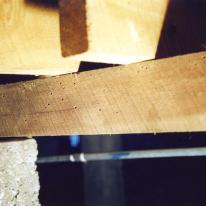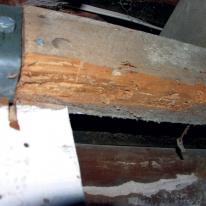Borer in bearers/joists/bottom plates
Listed under: timber and wood-based, timber, Subfloor, bracing, framing, moisture, durability, borer
Cause
Untreated or inadequately treated timber
Repair
- a few borer holes are not uncommon in older homes such as villas and bungalows. Unless the infestation is extreme, borer holes are unlikely to compromise the structural performance of the timber. (A lot of native framing timber has a high proportion of heartwood, and common borer only consume sapwood.). The best indication of whether borer are still active is the appearance of fresh holes and dust during their flying season from October to March
- if the infestation is extensive and there is considerable damage visible, you can treat the infestation yourself, or consult a specialist pest destruction company that is a member of the Pest Management Association of New Zealand
- replace badly infected timber with minimum H1.2-treated timber. Another option for joists is to strengthen infected timber by fixing new timber to affected timber once the infestation has been treated. Ensure that new timber extends a minimum of 600 mm beyond the infected area
- if you engage a tradesperson to carry out the work, they must be a licensed building practitioner or the work must be supervised by an LBP
Cause
Use of sap timber
Repair
- see the first repair above
Cause
High subfloor moisture levels
Repair
- first, identify the source of the moisture and deal with that
- If there are leaky pipes, get them fixed. You can fix a broken downpipe that is discharging rainwater under the house yourself, but if the leak is in a waste pipe or drain, under law that must be fixed by a licensed or certifying plumber.
- If surface water is getting under the house, lower the ground levels around the building and slope the ground away from the house. Install channels or sub-surface drains and discharge into a stormwater drain or soak pit
- remove anything sitting hard against the house perimeter that is blocking ventilation such as raised garden beds, dense planting, piles of timber or bricks etc.
- ensure good subfloor ventilation. Provide not less than 3500 mm² of clear open subfloor venting (grilles or gaps between baseboards) for every 1 m² of floor area. Spread vents evenly around the building perimeter to allow cross-ventilation
- lay polythene sheeting at least 0.25 mm thick to completely cover the ground under the house. Ensure that the ground is shaped so no water accumulates on top of the polythene. Polythene sheets should be lapped a minimum of 150 mm, preferably taped, and tightly butted up to foundation walls and piles. Weigh down the sheets with bricks or concrete to avoid them being displaced by air movement from subfloor ventilation.
- see the first repair above for treatment and repair or replacement of the framing timber






